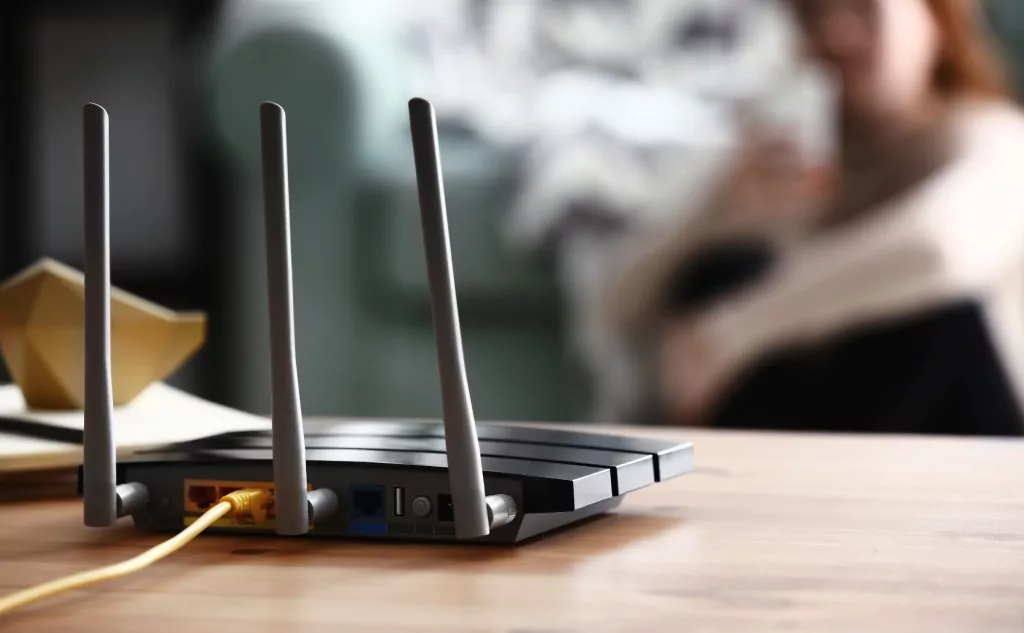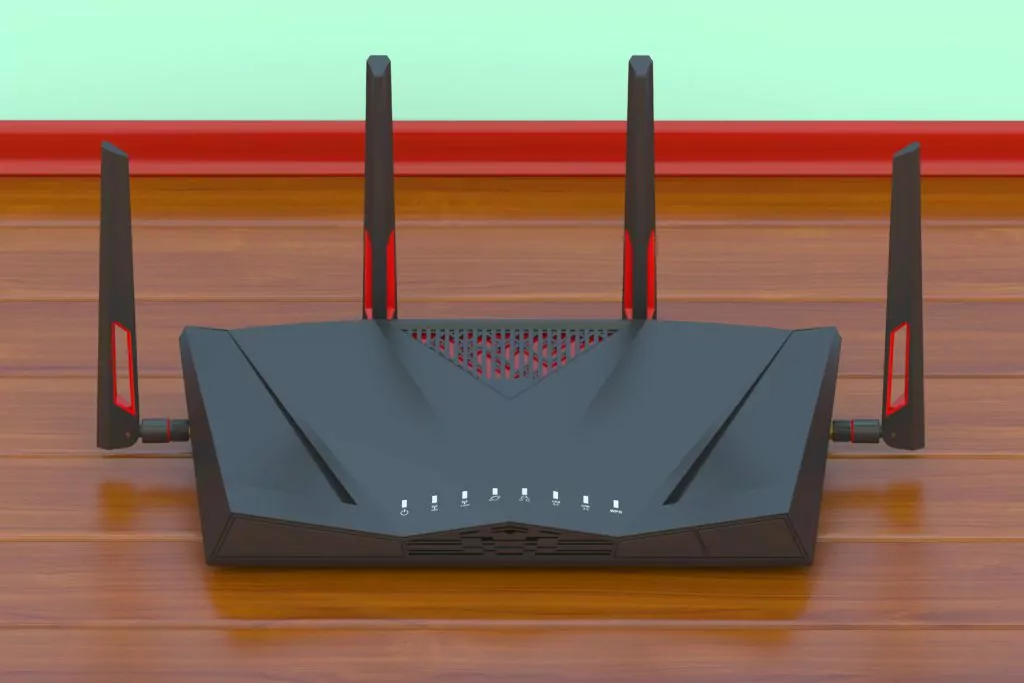This is about how to tell whether your router is a dual-band.
There are single-band, dual-band, and tri-band routers.
If you want to figure out what kind of router you have, then this article is for you.
Let’s jump right in!

How Can You Tell Whether Your Router Is a Dual Band?
Today, home internet is a basic necessity.
Your router plays a critical role in your Wi-Fi connectivity, but learning the differences between “single-band,” “dual-band,” and “tri-band” is, admittedly, overwhelming.
And if you’re confused by the tech-speak and wondering, “How do I check if my router is dual band?” you’re not alone.
Below you’ll learn the distinguishing features of dual-band routers and how they can boost your home Wi-Fi performance for all your devices and web activities.
What is a Router Band?
First, what is a router band?
Whenever you connect a mobile phone, computer, tablet, or another WiFi-enabled electronic device to your router, the router transfers a wireless signal to your device.
The frequency used to transmit the signal is known as a “band” or “frequency band,” which differs slightly between router types.
Routers can either be single-band or dual-band, each using 2.4 GHz, 5 GHz, or both.
What is a Dual Band Router?
A dual-band router transmits and receives wireless signals on two different frequency bands, 2.4GHz and 5GHz, using one at a time or both simultaneously.
By taking advantage of two bands at once, dual-band routers allow more flexibility and security for your internet activity.

Plus, only more recent digital devices work with 5 GHz. Fewer compatible devices mean less congestion, lending the device better bandwidth.
Dual-band routers use “load balancing,” allowing the device to split your internet usage between two bands, enhancing performance reliability and boosting internet speeds.
For example, the 2.4 GHz band may transmit several devices’ data while the 5 GHz band transfers video. This reduces the traffic per band, improving coverage while upholding good connectivity and speed across all devices.
Differences Between a Single Band, Dual-Band, and Tri-Band Router
There are three primary router types, each designed to operate using one or more of the bands discussed thus far in various combinations.
If you’re stuck wondering, “How can I tell if my router is dual band or another type?” Here are some crucial details to help you find out.
Single-band routers
Being the oldest kind of router on the list, single-band routers include just a single 2.4 GHz frequency band.
If you have a single-band router, all WiFi-connected phones, tablets, and gaming consoles in your home run on this band.
Single-band routers work relatively well for home Wi-Fi networks, primarily because they are the best at penetrating physical barriers, such as walls and furniture. This allows the signal to travel farther than a 5 GHz band.
Still, because so many devices use this band, it tends to be quite crowded, leading to lower speeds and higher chances of interference.
Dual-band routers
These dual-band routers use both 2.4 GHz and 5 GHz bands. With traffic divided between both pathways, you’re able to play games or surf the web with less interference. (That is, if the router uses both simultaneously. These might transmit signals on one band at a time.)
This is, in part, because 5 GHz has 24 non-overlapping channels – significantly more than the three dedicated to 2.4 GHz. These channels are essentially “Wi-Fi highways” that allow various devices to “talk” (transmit data) over Wi-Fi.
(You’ll usually only see up to 12 options, but this is still much more than 2.4 GHz. The numerous options greatly reduce instances of interference, and thus, lag.)
Dual-band routers’ main weakness is their lower efficiency in penetrating solid surfaces. This shortens the range a bit but doesn’t significantly affect performance speed.
Tri-band routers
Tri-band routers are a worthwhile investment, depending on how much WiFi your household consumes.
It’s the most recent addition to the market of the three router types. They feature one 2.4GHz band and two 5GHz signals.
The reason having two 5 GHz bands is ideal is because they provide a much stronger performance than the alternatives.
This router offers the same advantages as the dual-band but better, due to the additional band.
Do Dual-Band Routers Perform Better than Single Band Routers?
Regarding performance, there’s no doubt that dual-band routers perform better than single-band routers.
To understand why you should know the main differences between 2 GHz and 5 GHz bands:
- 5 GHz has a higher data transmission rate than 2.4 GHz
- 2 GHz has a larger coverage area, yet a slower performance
- 5 GHz is less prone to interference due to more non-overlapping channels options and less congestion from devices
What’s the bottom line here? Since dual-band routers can use both 5 GHz and 2.4 GHz, they are generally better than single-band routers. Still, both have their strengths.
For instance, a dual-band router is much better for gaming and video chatting, especially when you’re sitting closer to the router.

If you’re farther away (say, in another room, requiring the signal to move through walls) using a device like a smartphone, then 2.4 GHz is just fine.
Key Pros and Cons of a Dual-Band Router
Here are some key benefits and drawbacks to consider when it comes to a dual-band router:
Advantages:
- Better bandwidth than single-band routers
- Less congestion from Wi-Fi connected devices
- Can use one or both bands for optimal performance, 2.4 GHz and 5 GHz
- Less vulnerable to interference
Disadvantages:
- Slightly more high-priced than single-band routers
- Smaller coverage area than 2.4 GHz (since it can’t penetrate solid barriers as well)
How Do I Know if My Router is Single or Dual Band?
People frequently ask, “how do I know if my router is dual band?” Learning to identify whether the routers are single-band or dual-band is the first step to understanding routers.
Follow the steps below to find out on a Windows device:
- Type “cmd” in your Start menu. This should bring up the Command Prompt desktop app.
- Select the Command Prompt app to open the input window.
- Input “netsh wlan show drivers” and press Enter.
- In the information presented, you’ll see “Radio types supported” on the bottom of the window. Read the information here (it should list several numbers, including 802.11ac and 802.11n).
- If it says 802.11ac, your network is dual-band compatible. On the other hand, 802.11n means your network might be compatible with a dual-band router.
- Now, try to connect to a 5 GHz network. This will appear as the network name with a “5G” at the end. If the option doesn’t show up, you either:
- Don’t have a dual-band router.
- Don’t have a dual-band compatible device.
- To determine whether the problem lies with the router or the device, you can:
- Check the router for labeling stating that it is dual-band.
- Check the manufacturer’s website or the router’s manual where that information should be prominently displayed.
How To Know if You Need a Dual-Band Router
When choosing the right router, ask yourself, how does your household use the internet?
If you have a large household that tends to do a lot of streaming on Netflix, Hulu, and other TV services or online gaming, a dual-band router is the way to go.
To get over any hiccups in coverage throughout the house, a simple signal booster will do the trick.
However, if your household consumes WiFi for low-bandwidth activities (endless Twitter scrolling or messaging on WhatsApp and other chat apps), you might not need a dual-band router.
That being said, if your internet-enabled devices are older and not compatible with 5 GHz frequency, then a dual-band router can’t do much for you.
Finding the Right Dual-Band Router
When browsing router options, you’ll want to consider the rate of internet speed your home requires.
Transferring files, streaming high-quality videos, and gaming online all use more bandwidth than scrolling Instagram or Twitter.
Remember that a manufacturers’ advertised speed might be somewhat misleading, as theoretical and actual internet speeds vary.
(For example, providers may promise speeds ranging from 11-300 Mbps on a 2 GHz router, but the real-world speed may only amount to 1-150 Mbps.)
Your environment, time of day, Wi-Fi provider, and more all influence your internet performance.

Next, think about your budget. If you need WiFi for crucial tasks like at-home working or online schooling, you may need to spend a bit more on a reliable, high-end dual-band router.
These are often equipped with enhanced features such as better malware protection, additional I/O ports (the point at which data is transferred to/from your device), and more.
FAQs
Below are some frequently asked questions from internet users.
How much is a dual-band router?
Dual-band routers cost anywhere between $50 and $350. But for routers with more high-end features, expect to pay slightly higher prices.
What is the network speed of a dual-band router?
A dual-band router can deliver 1.3 Gbps on an 802.11ac Wi-Fi network or 450 Mbps on 802.11n. (This may vary depending on the internet provider and network congestion.)
What is a dual router compatible with?
Dual-band routers support any internet-enabled device, but older and incompatible models will have to use the 2.4GHz frequency band.
Are there dual-band modems?
Routers and modems are frequently sold as a single device, so if you have a dual-band modem, you may have a joined dual-band modem-router.
Essentially, a modem works as the medium between your ISP (Internet Service Provider) and your router.
The modem connects your router to the internet, and the router lets your personal devices access the internet.

